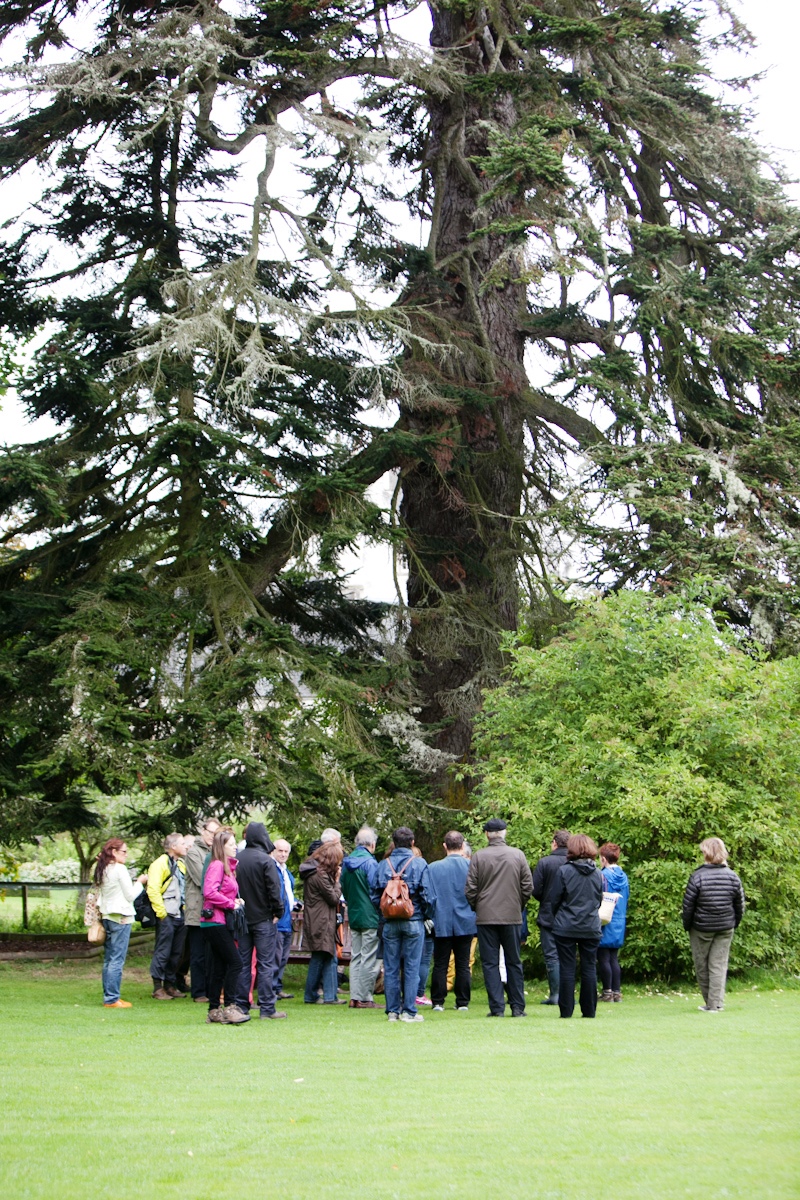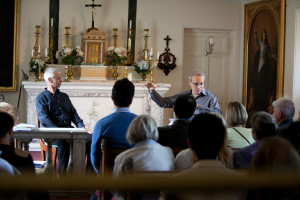
આ 4મી પુસ્તકો, બોર્ડર્સ અને બાઇક ફેસ્ટિવલ સ્કોટલેન્ડના સૌથી લાંબા સતત વસવાટવાળા નિવાસસ્થાનમાં યોજાયો હતો, સ્કોટિશ બોર્ડર્સમાં ટ્વીડ નદી પર ટ્રક્વેયર હાઉસ. બિયોન્ડ બોર્ડર્સ સ્કોટલેન્ડ દ્વારા આયોજિત આ સાહિત્ય અને વિચારનો અનોખો તહેવાર છે જે અગ્રણી લેખકોને એકસાથે લાવે છે, રાજકારણીઓ, સૈનિકો, વકીલો અને કલાકારો આંતરરાષ્ટ્રીય સંબંધો સ્કોટલેન્ડની વિશ્વમાં ભૂમિકાને લગતા વિષયો પર ચર્ચા કરવા. બે વાટાઘાટો “ઈસ્લામિક વિશ્વને સમજવું” અને “ઈરાક દસ વર્ષ ચાલુ છે: સીરિયા અને યુએન માટે શું પાઠ?” ચર્ચાની પહોળાઈ માટે વસિયતનામું ધરાવો. SNSI સંયોજક, રોબર્ટ વાઇલ્ડે બે ઇવેન્ટમાં ભાગ લીધો હતો; એક વોક શીર્ષક "જો વૃક્ષો વાત કરી શકે છે – તેઓ શું કહેશે?", અને "પ્રાચીન અને પવિત્ર કુદરતી સ્થળોના ન્યુરોસાયન્સ" પર વાર્તાલાપ.

ઇયાન એડવર્ડ્સ સાથે ટ્રાયલ પર જૂથ, રોયલ બોટેનિક ગાર્ડન એડિનબર્ગ ખાતે ઇવેન્ટ્સના વડા, વૃક્ષોના સાંસ્કૃતિક જોડાણની ચર્ચા કરતી વખતે કેથરિન મેક્સવેલ કે જેનું કુટુંબ કેટલા સમયથી રહે છે 300 વર્ષો વૃક્ષોનો ઇતિહાસ પ્રદાન કરે છે. (ફોટા સૌજન્ય બિયોન્ડ બોર્ડર્સ)
રવિવારની મોર્નિંગ વોક હતી 'એ ટોકિંગ સાયન્સ પ્રોજેક્ટરોયલ બોટેનિક ગાર્ડન એડિનબર્ગ સાથે ભાગીદારીમાં. તેણે ટ્રેક્વેયરના ઐતિહાસિક લેન્ડસ્કેપની શોધ કરી અને તેના અદ્ભુત વૃક્ષોની વાર્તાઓ શોધી કાઢી (www.traquair.co.uk). ઇયાન એડવર્ડ્સ, રોયલ બોટેનિક ગાર્ડન એડિનબર્ગ ખાતે ઇવેન્ટ્સના વડા, જૈવ-ભૌગોલિક ઇતિહાસ અને યૂ સહિત એસ્ટેટના વૃક્ષોના સાંસ્કૃતિક સંગઠન પર ચર્ચાનું નેતૃત્વ કર્યું, ચૂનો, સિલ્વર ફિર અને હેઝલ. કેથરિન મેક્સવેલ સ્ટુઅર્ટ, માલિક અને જેના પરિવાર માટે રહેઠાણ છે 300 વર્ષો વૃક્ષોનો ઇતિહાસ પ્રદાન કરે છે.
આ જૂથે પ્રાચીન યૂઝ દ્વારા બનાવેલ ચિંતનશીલ સ્થળની અંદર ચર્ચા પૂરી કરી જે કદાચ હવે સાફ કરાયેલા એટ્રિક ફોરેસ્ટના સમયથી અસ્તિત્વમાં છે જ્યાં ટ્રેક્વેયર હાઉસ - સ્કોટિશ રાજાઓની શિકારની જગ્યા છે. 1107 - મૂળ સ્થિત થયેલ હતું. રોબર્ટે પોઝ આપ્યો કે જો વૃક્ષો વાત કરી શકે તો તેઓને આપણા જેવા કેટલાક પ્રશ્નો હોઈ શકે છે: તમે એટ્રિક ફોરેસ્ટનું શું કર્યું? તમે પૃથ્વી પરના અડધા જંગલોનું શું કર્યું છે? શું તમે કલ્પના કરો છો કે તમે વૃક્ષોની અમારી સંભાળ રાખો છો? ખરેખર અમે તમારી સંભાળ રાખીએ છીએ!
વૉક પછી ભરચક ચેપલની અંદર વાત થઈ. શીર્ષકપ્રાચીન અને પવિત્ર કુદરતી સ્થળોનું ન્યુરોસાયન્સ: ડબલ્યુહાય પ્રાચીન સ્થળોએ આપણી સંસ્કૃતિ પર આટલી શક્તિશાળી પકડ ઉભી કરી છે અને સંઘર્ષના સમયે તેનું રક્ષણ કરવું જોઈએ”, આ ટોકમાં સેક્રેડ નેચરલ સાઇટ્સની શોધ કરવામાં આવી હતી અને ન્યુરોસાયન્સની ઉભરતી સમજણની લિંક્સ બનાવવામાં આવી હતી..
રોબર્ટે કહ્યું કે પવિત્ર પ્રાકૃતિક સ્થળોને એવા સ્થાનો તરીકે વર્ણવી શકાય છે જ્યાં માનવ મન કુદરતને મળે છે.. તેમણે જોયું કે Traquair ચેપલ (જે આ હેતુ માટે પ્રમાણમાં નવું છે 1829) પ્રકૃતિના થોડા સંકેતો હતા પરંતુ તે સંભવ છે કે આપણી બધી પવિત્ર જગ્યાઓ મૂળરૂપે પ્રકૃતિમાંથી ઉતરી આવી છે..
રોબર્ટે પવિત્ર પ્રાકૃતિક સ્થળોનું વર્ણન કર્યું અને શા માટે તેઓએ આંતરરાષ્ટ્રીય સંરક્ષણ ચળવળમાં રસ મેળવ્યો.. કુદરત સંરક્ષણ પ્રેક્ટિશનરો પવિત્ર કુદરતી સ્થળોમાં ખૂબ જ વ્યવહારિક રસ ધરાવે છે કારણ કે તેઓ દુર્લભ પ્રજાતિઓની વિશાળ શ્રેણીનું રક્ષણ કરે છે.. આ ખાસ કરીને મહત્વનું છે કારણ કે આપણે હવે પ્રવેશ કર્યો છે 7મી મહાન લુપ્ત થવાની ઘટના, દરરોજ સેંકડો પ્રજાતિઓ લુપ્ત થઈ રહી છે. આનાથી આગળ, જો કે, પવિત્ર પ્રાકૃતિક સ્થળોએ માનવ સંબંધોના આર્કાઇટાઇપ્સના ઊંડા સમૂહને પણ એમ્બેડ કરે છે જેમાંથી આપણે માનવતા માટે વધુ ટકાઉ માર્ગ નક્કી કરવા માટે શીખી શકીએ છીએ..
આવો જ એક ખ્યાલ છે કે 'અભયારણ્ય' તે પ્રાચીન યુરોપીયન પવિત્ર ગ્રુવ્સમાંથી પ્રારંભિક ખ્રિસ્તી ચર્ચમાં સીધી આયાત હોવાનું જણાય છે. અભયારણ્ય યુરોપના પવિત્ર ગ્રુવ્સમાં ઉભું થયું જ્યાં, કોઈ શિકારની મંજૂરી ન હતી અને જો શિકાર કરાયેલ પ્રાણીને પવિત્ર ગ્રોવમાં આશરો મળે તો શિકાર બંધ કરવો પડ્યો હતો. માનવ ભાગેડુઓને પણ પવિત્ર ગ્રોવમાં અભયારણ્ય મળી શકે છે. આમાંની ઘણી જોગવાઈઓ હજુ પણ આફ્રિકા અને એશિયાના પવિત્ર ગ્રોવ્સમાં છે. અમુક સમયે આ અભયારણ્ય સિદ્ધાંત ચર્ચમાં સ્થાનાંતરિત થયો.

પવિત્રના ન્યુરોસાયન્સમાં પ્રવેશતા પહેલા, રોબર્ટ વાઇલ્ડ (બાકી) સંઘર્ષને મર્યાદિત કરવાના સંભવિત વિસ્તારો તરીકે પવિત્ર સ્થળોની શોધ કરી. (ફોટા સૌજન્ય બિયોન્ડ બોર્ડર્સ)
છેલ્લે, અને પવિત્ર ના ન્યુરોસાયન્સમાં પ્રવેશતા પહેલા, રોબે સંઘર્ષને મર્યાદિત કરવાના સંભવિત વિસ્તારો તરીકે પવિત્ર સ્થળો પર ધ્યાન કેન્દ્રિત કર્યું. રોબે તાજેતરમાં સાથીદારો દ્વારા શેર કરેલ ઉદાહરણ રજૂ કર્યું Aigine સાંસ્કૃતિક સંશોધન કેન્દ્ર સંબંધિત 2010 કિર્ગીઝ સંઘર્ષ જ્યાં સેંકડો લોકો માર્યા ગયા અને હજારો વિસ્થાપિત થયા દેશના દક્ષિણમાં કિર્ગીઝ અને ઉઝબેક વચ્ચે સંઘર્ષ. ઘણા વિસ્થાપિત રહેવાસીઓને સંઘર્ષના સમયે સુરક્ષિત આશ્રયસ્થાન તરીકે પવિત્ર સ્થળમાં આશરો મળ્યો:
"કામચીવા મોપાશા એક વંશીય ઉઝબેક મહિલા અને 'શેક્સ' અથવા સાઇટના વાલી જણાવે છે: “જ્યારે કોઈ આફત આવે છે, લોકો આ મંદિરમાં આવે છે અને આશરો મેળવે છે". તેણીના જણાવ્યા મુજબ, જૂનમાં સંઘર્ષની ટોચ પર 2010, [ઘણા લોકો] કિર્ગીઝ અને ઉઝબેક બંને ત્યાં ગયા, પરંતુ તેઓ પૂછતા ન હતા કે કોણ કોણ છે, [પરંતુ] સાથે મળીને ભગવાનને બલિદાન આપ્યું, શાંતિ અને સંવાદિતાની પુનઃસ્થાપના માટે વિનંતી કરે છે. ઘણા યાત્રાળુઓ તે બે-ત્રણ દિવસ રોકાયા હતા [સંઘર્ષની] મઝારની ધાર પર (પવિત્ર સ્થળ). તરીકે [એક ઇન્ટરવ્યુ લેનાર] અકબારોવ સાલ્બરે જણાવ્યું હતું, "એક નાક અથવા એક મોં ઘાયલ થયું નથી". અન્ય એક મુલાકાતીએ કહ્યું કે પવિત્ર સ્થાનો અહિંસાના ક્ષેત્રો છે, અને તે ઉપરાંત સ્થાનો જ્યાં હિંસા પર કાબુ મેળવવા માટે પગલાં લેવામાં આવે છે”.
આ સમયે રોબર્ટે પછી ટિમ ફિલિપ્સને સોંપી દીધો. ટિમ આંતરરાષ્ટ્રીય શાંતિ નિર્માતા અને સહ-સ્થાપક છે ટાઇમ્સ ઓફ ટ્રાન્ઝિશનમાં ન્યાય પર હાર્વર્ડ યુનિવર્સિટી પ્રોજેક્ટ અને ઉત્તરી આયર્લેન્ડ સહિત ઘણી શાંતિ વાટાઘાટોમાં સામેલ છે, શ્રીલંકા અને મધ્ય પૂર્વ.
ટિમ એ ન્યુરોસાયન્સની ઉભરતી શિસ્તનો પરિચય આપ્યો અને તાજેતરના પાઠોની ચર્ચા કરી જે સંઘર્ષના નિરાકરણના સંબંધમાં શીખી રહ્યાં છે.. આમાં મગજના જુદા જુદા ભાગોમાં વિવિધ પ્રકારની વિચારસરણીની પ્રક્રિયા થાય છે. મગજના જુદા જુદા ભાગો ઉત્ક્રાંતિના તબક્કાઓ સમાન હોય તેવા વિવિધ લાગણીઓ અને વિચારોની પ્રક્રિયા કરે છે. તર્કસંગત વિચાર હવે મગજના એક અલગ ભાગમાં પ્રક્રિયા કરવામાં આવે છે તે સમજવામાં આવે છે જે ઊંડાણપૂર્વક અને પવિત્ર મૂલ્યો ધરાવે છે.. આપણે જે રીતે મુદ્દાઓ પર વાટાઘાટો કરીએ છીએ તેના માટે આ નવી સમજણની ગહન અસરો છે. આ તે કેસ છે જ્યારે વાટાઘાટો કરતી ટીમો દ્વારા ઊંડાણપૂર્વક રાખવામાં આવેલા અથવા પવિત્ર મૂલ્યોના મોટે ભાગે તર્કસંગત ઉકેલો સરળતાથી ધ્યાનમાં લેવામાં આવશે નહીં..
પવિત્ર પ્રાકૃતિક સ્થળોએ એક જ સમયે શાંતિ અને સહકારની જગ્યાઓ પર હરીફાઈ કરવામાં આવી છે. તેઓ પ્રકૃતિ સાથેના માનવીય સંબંધોના નિર્ણાયક મોડલને પણ એમ્બેડ કરે છે. એવા સમયે જ્યારે પ્રકૃતિ સાથેના આપણા સંબંધોને નોંધપાત્ર ઉપચારની જરૂર હોય છે; આધ્યાત્મિક, માનવ વર્તન અને ક્રિયાની વૈજ્ઞાનિક અને સામાજિક સમજ જરૂરી છે.






